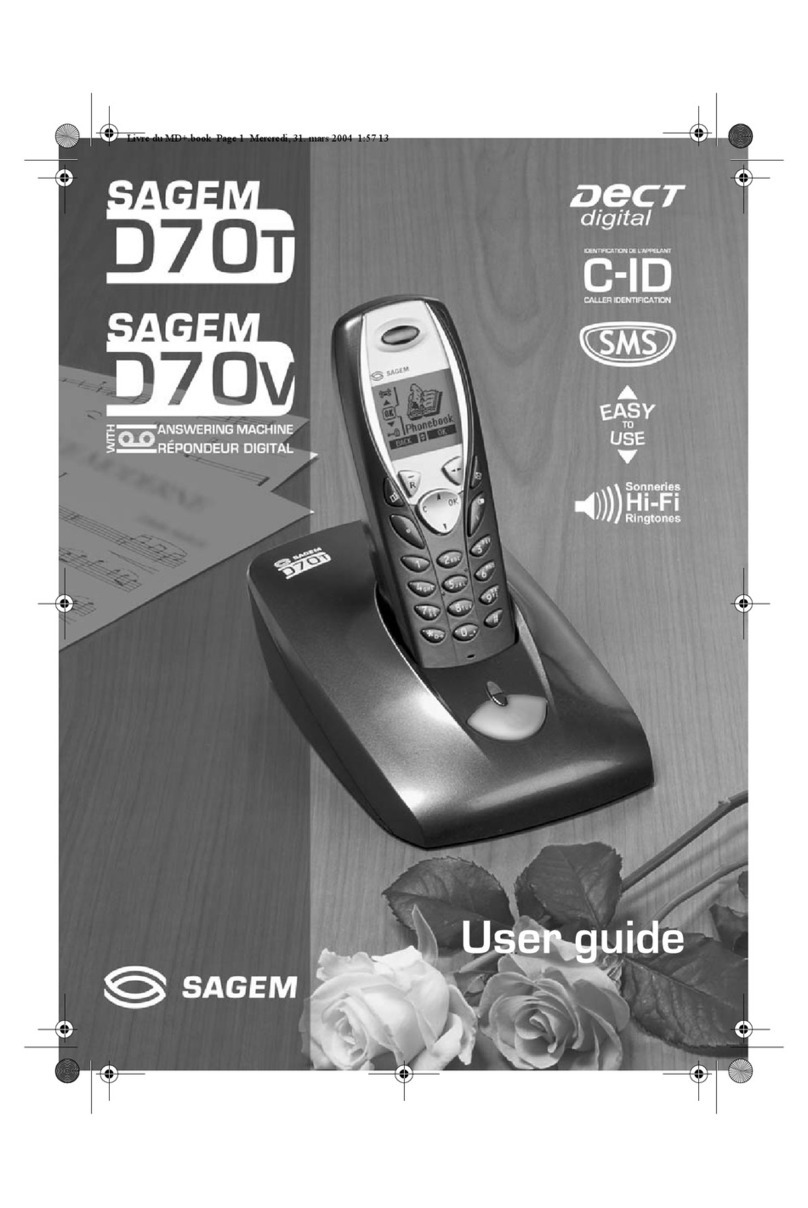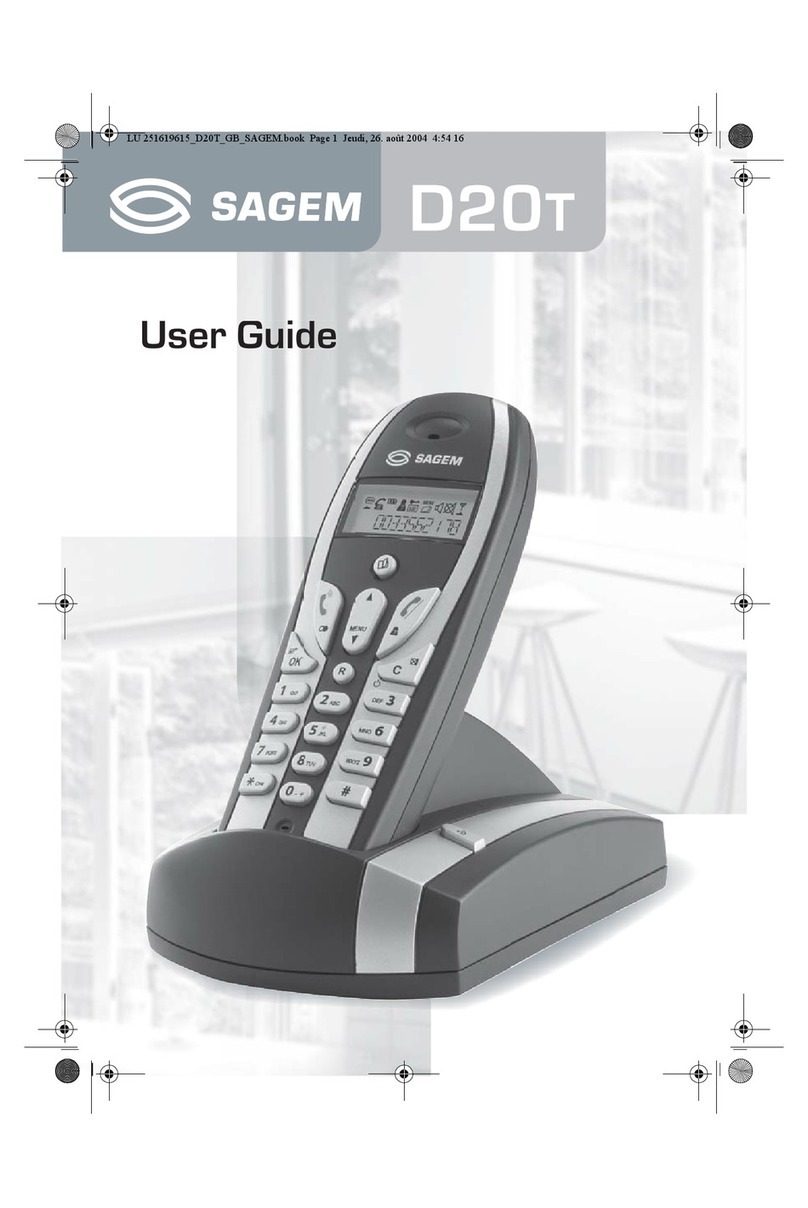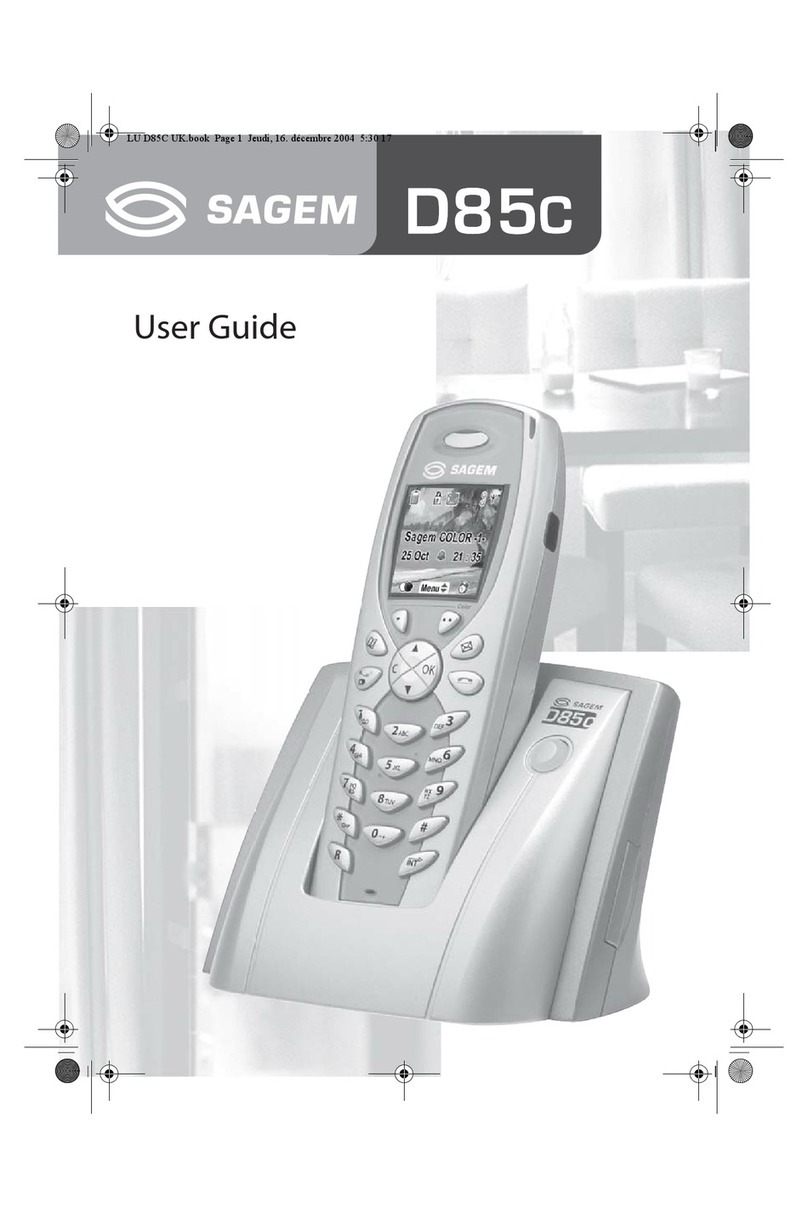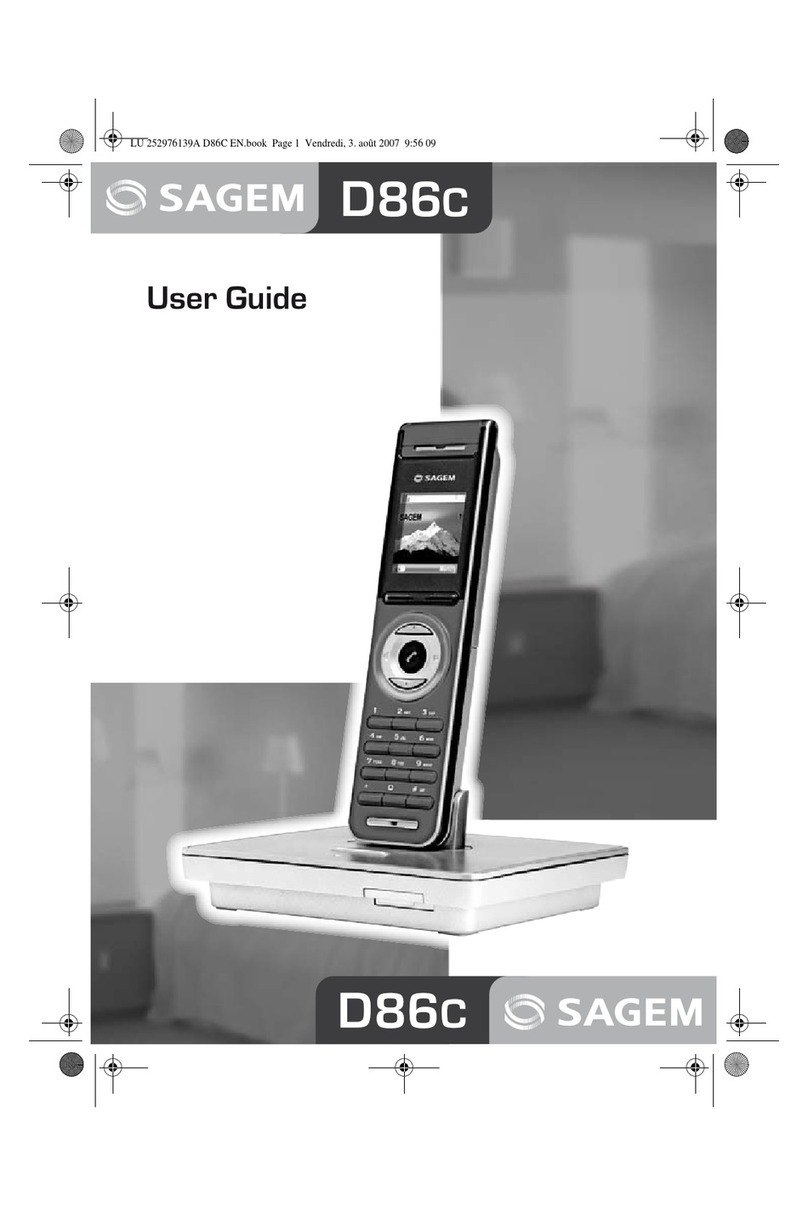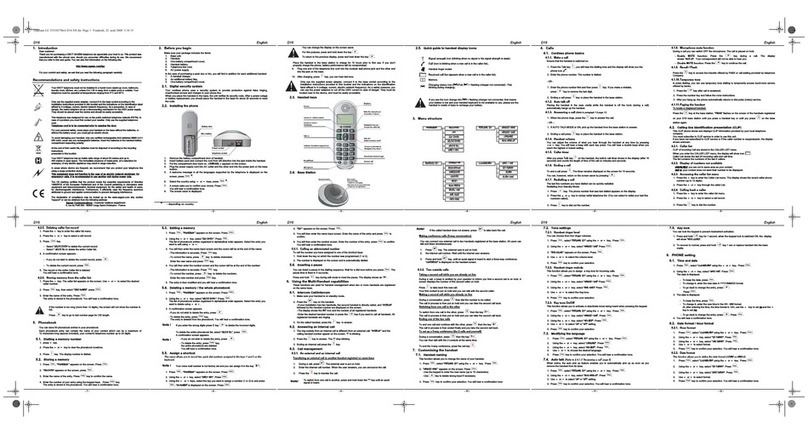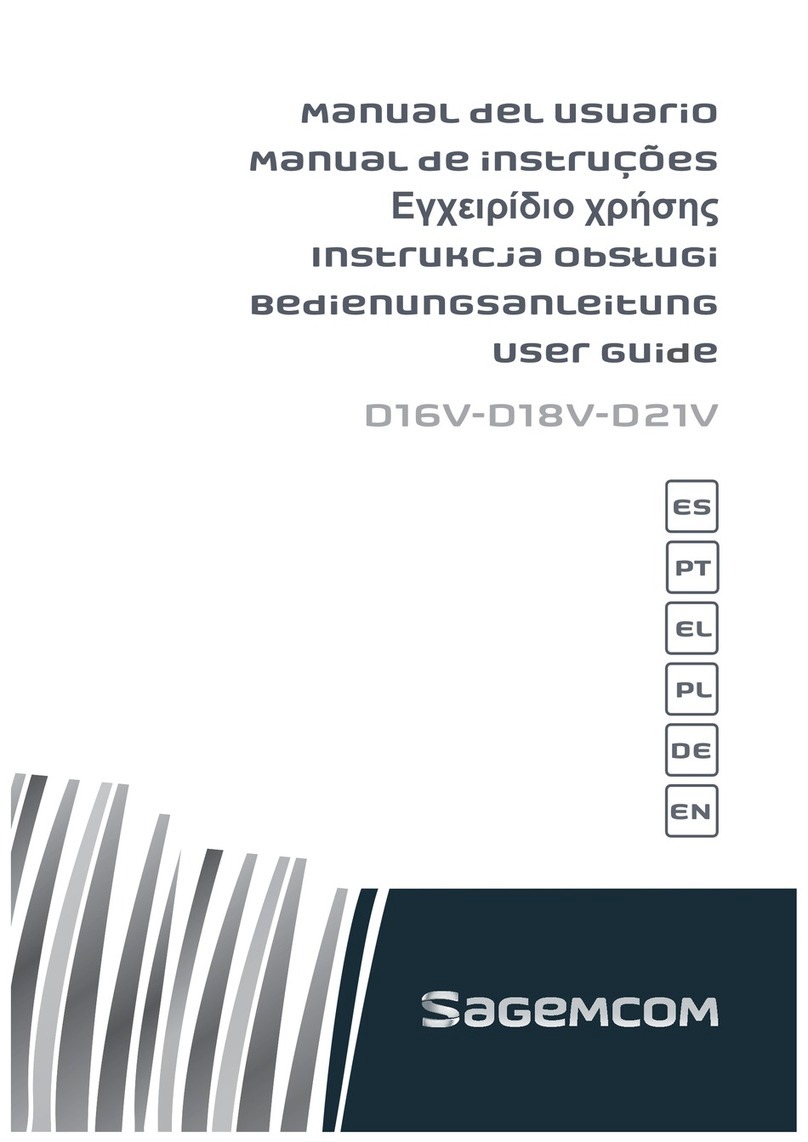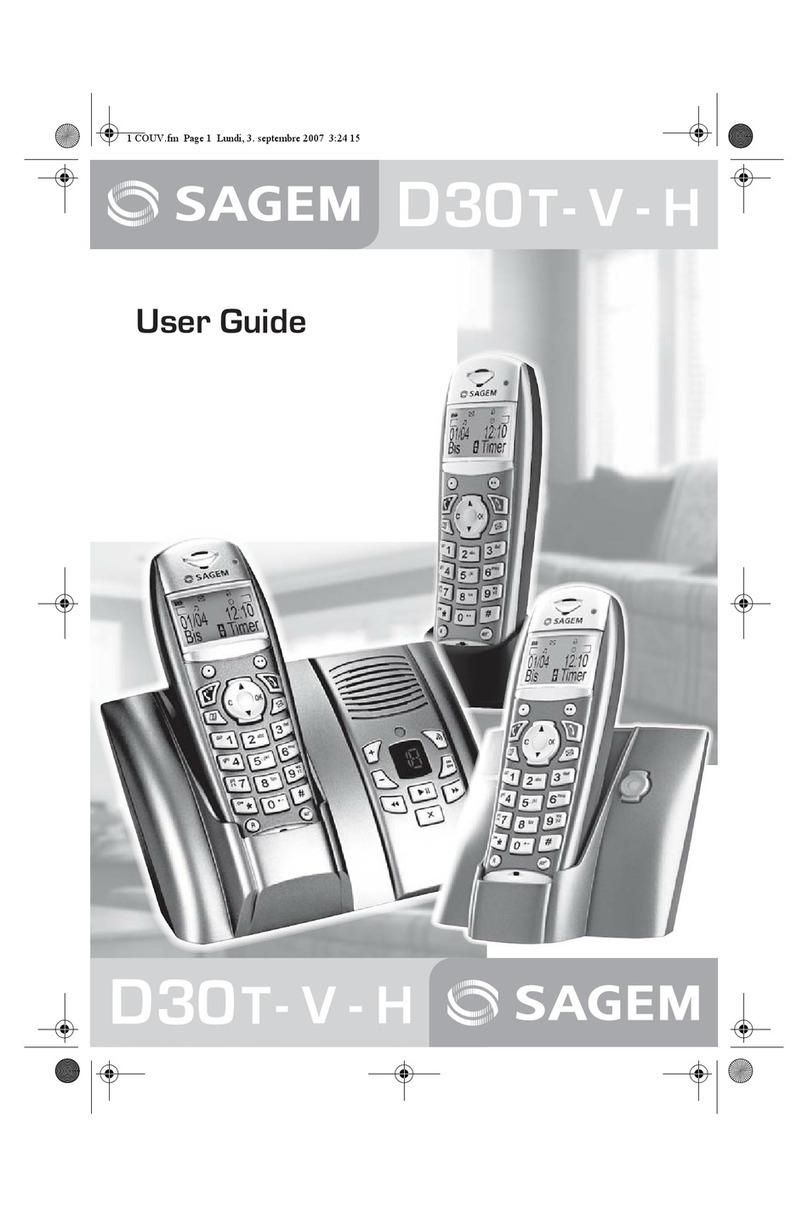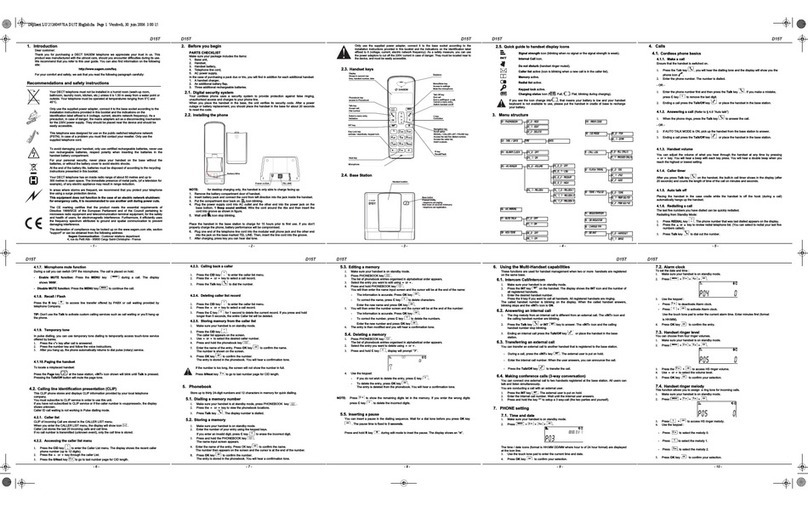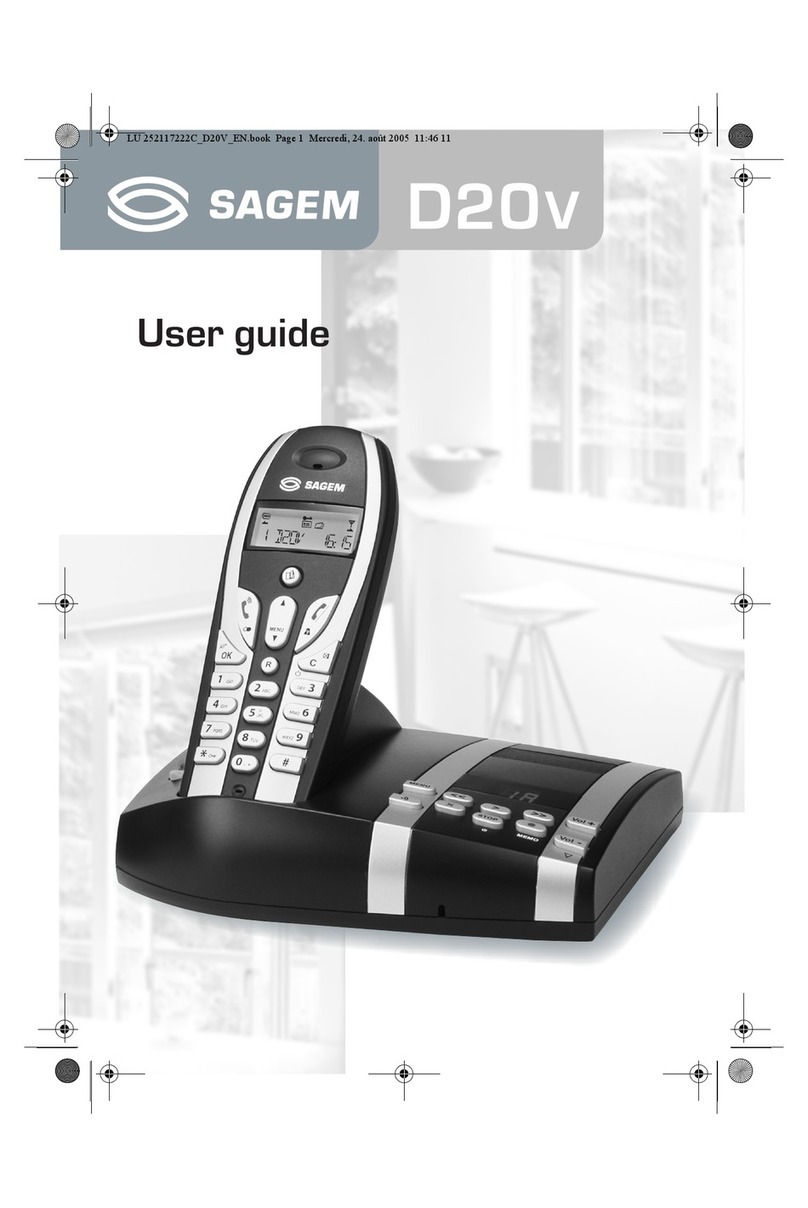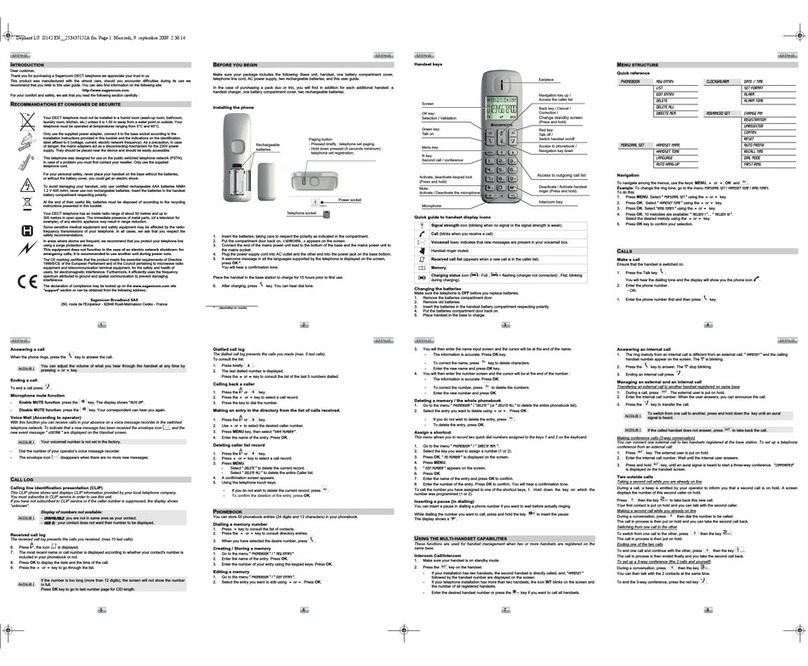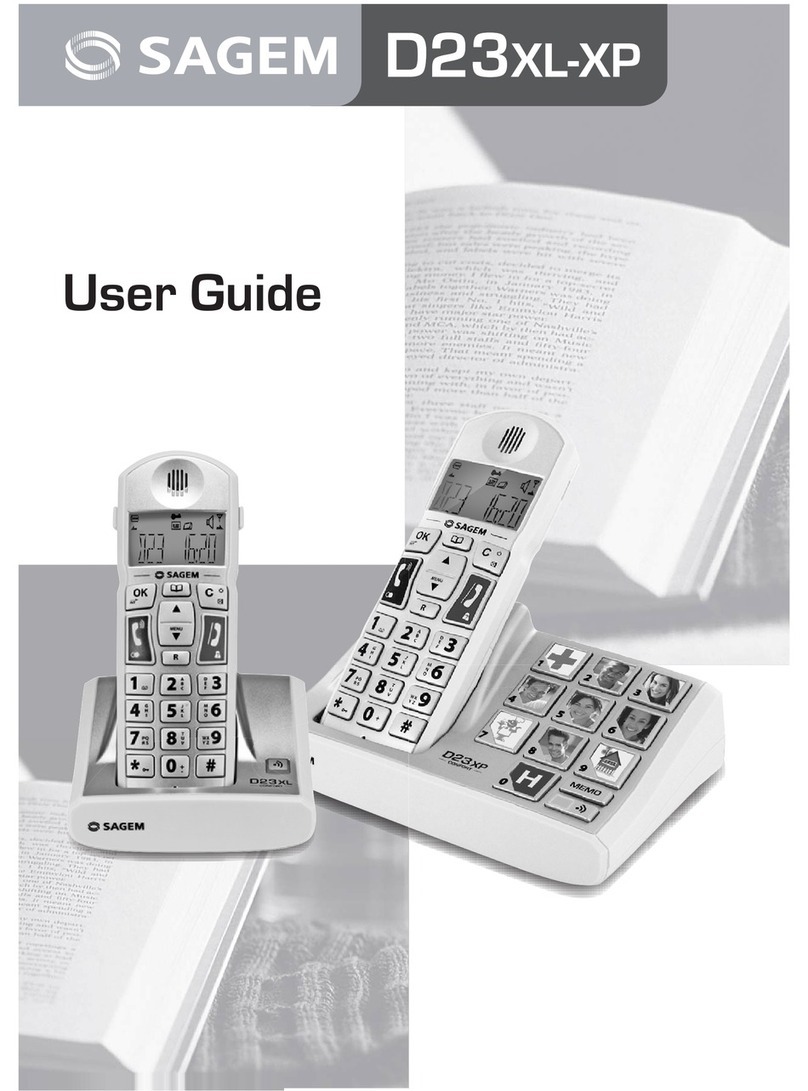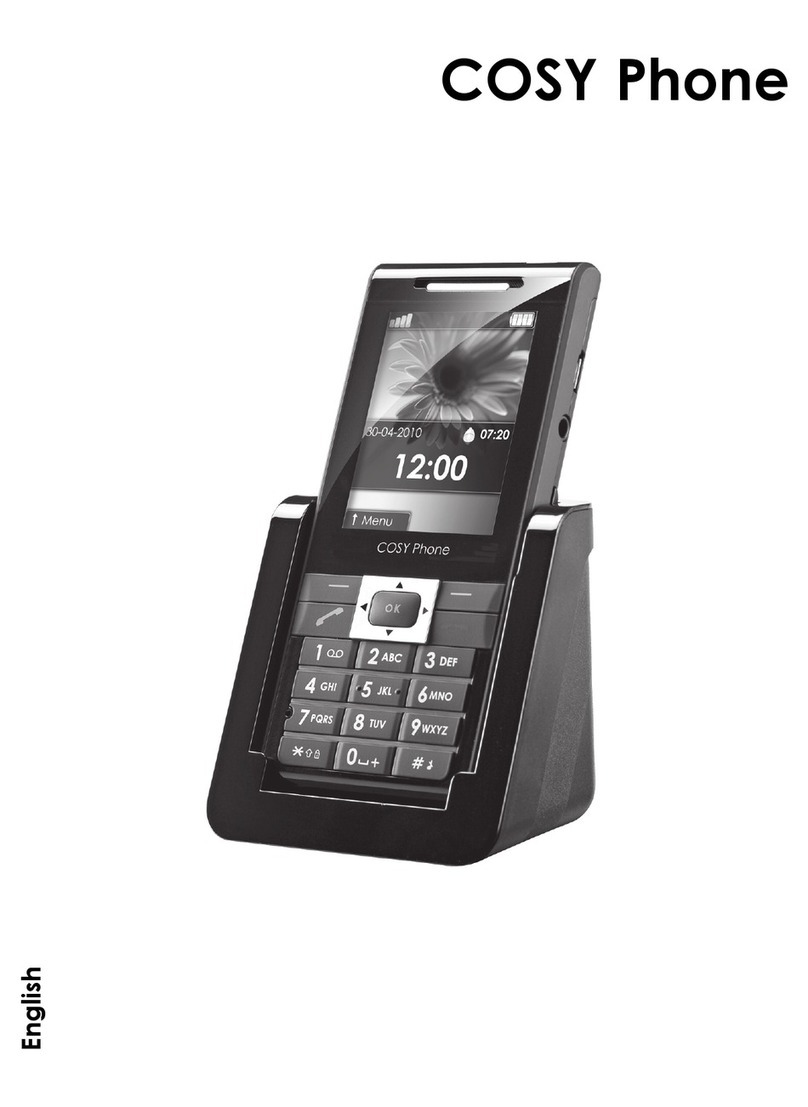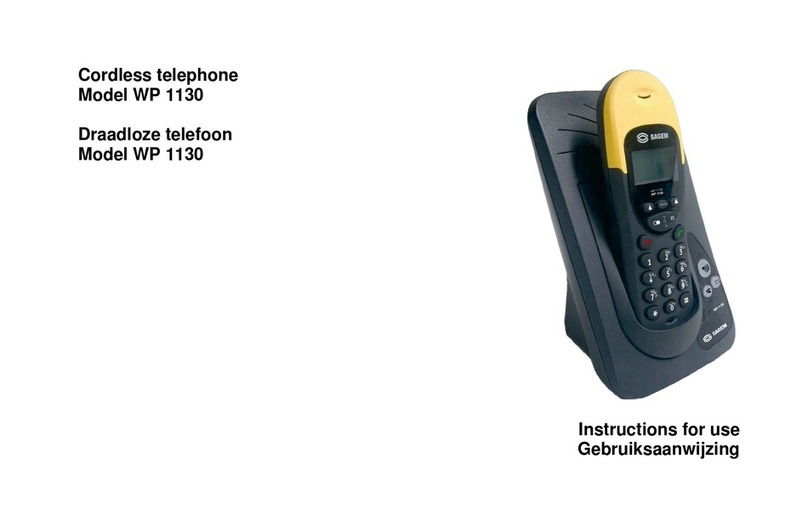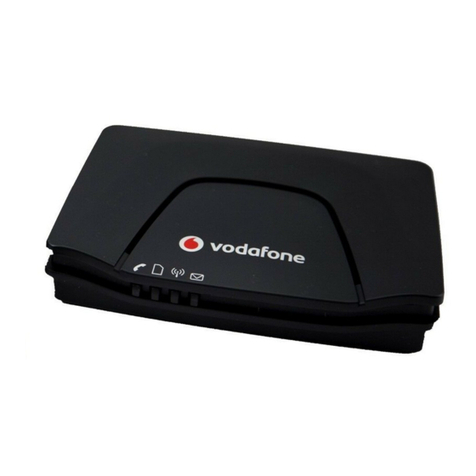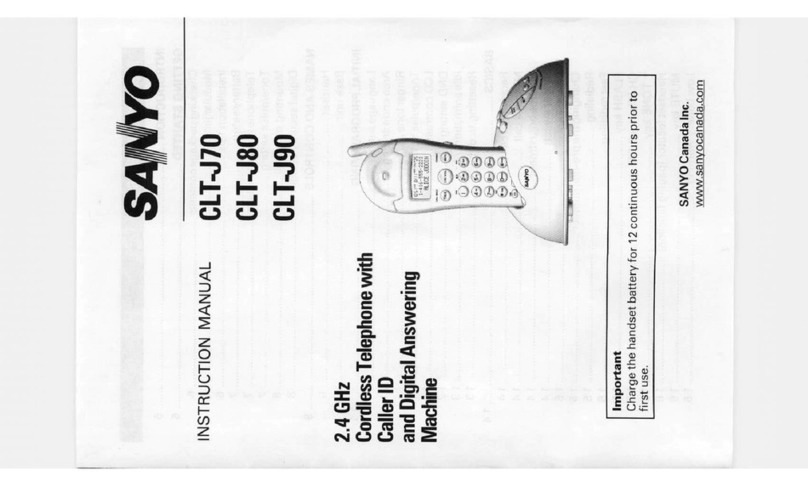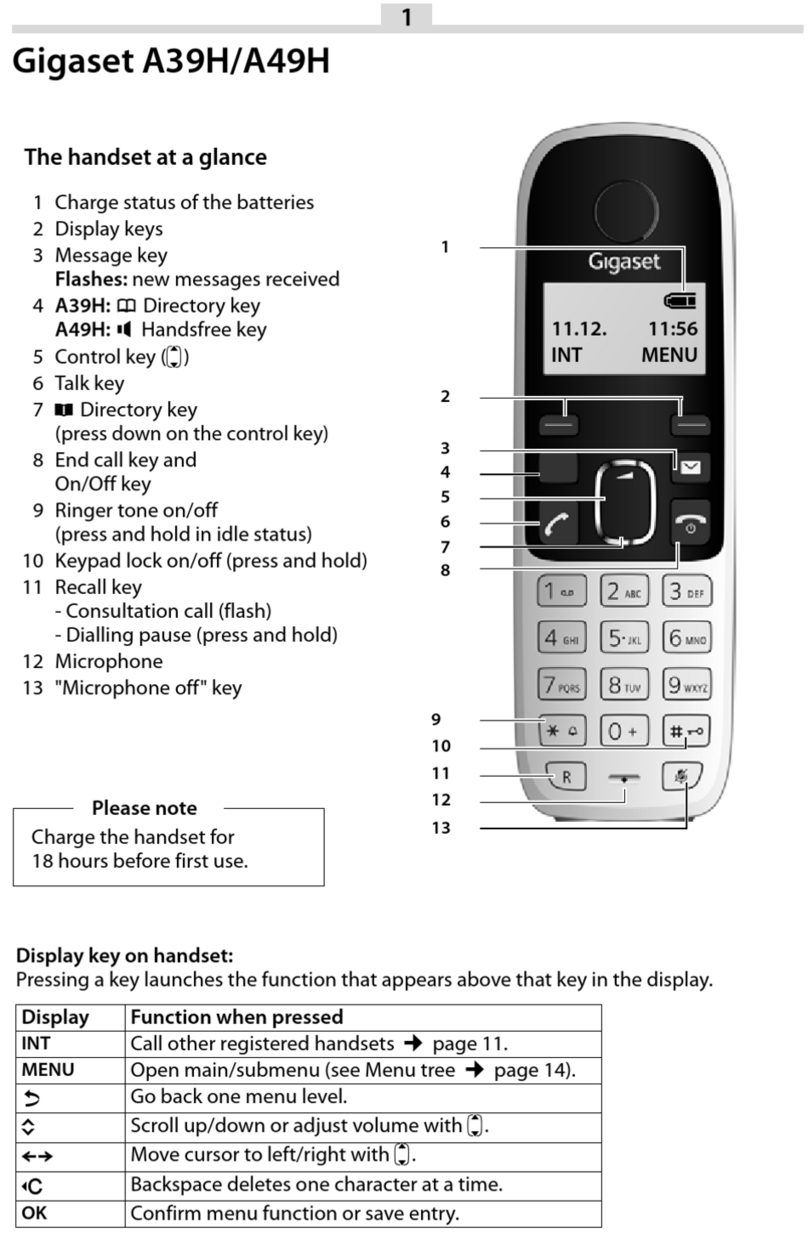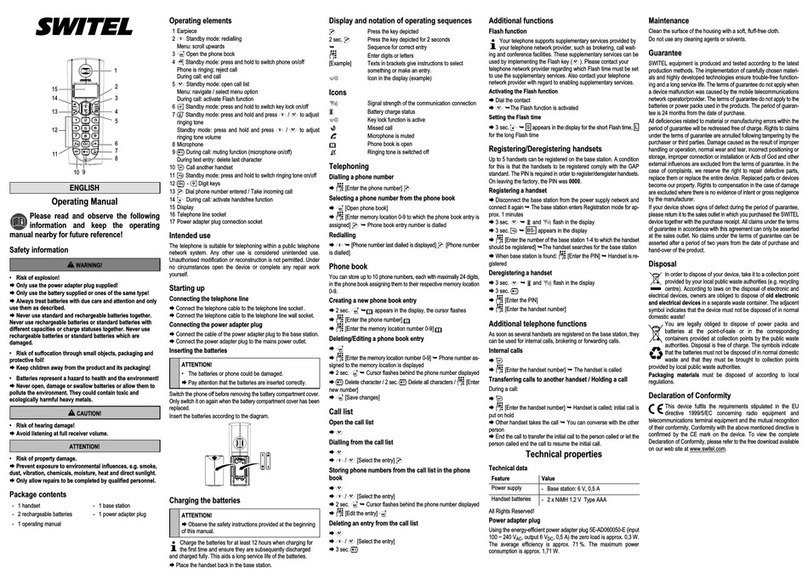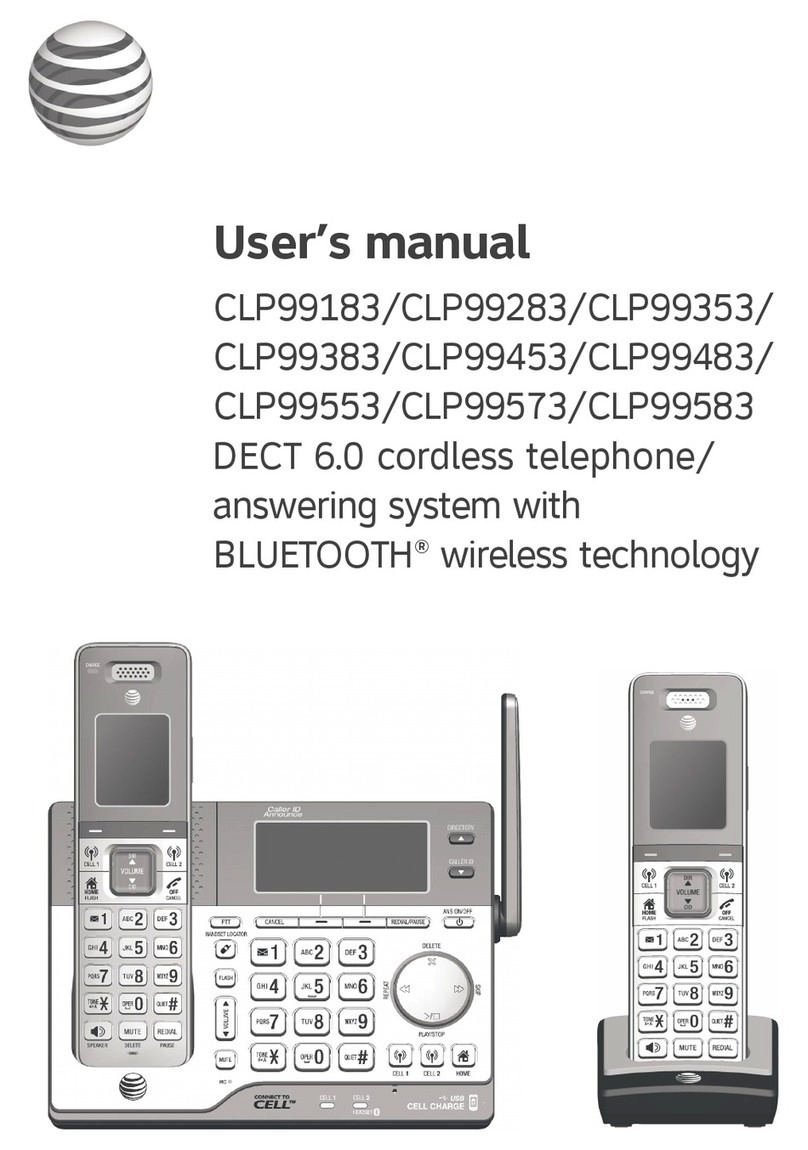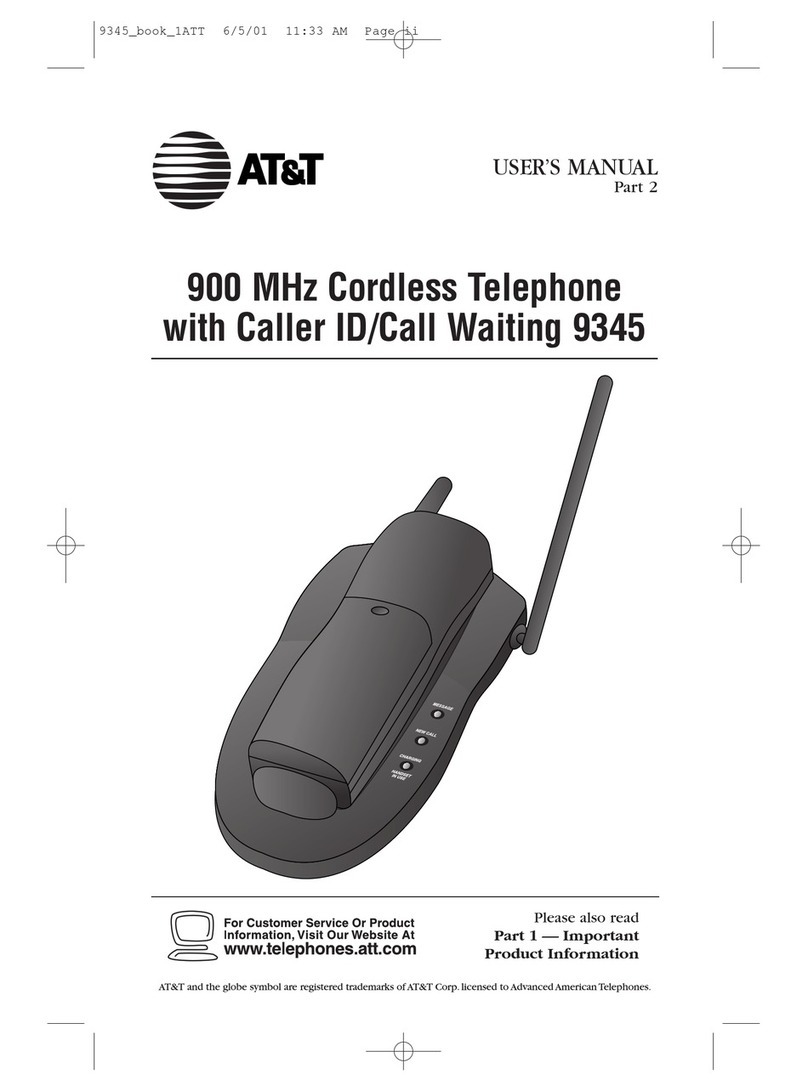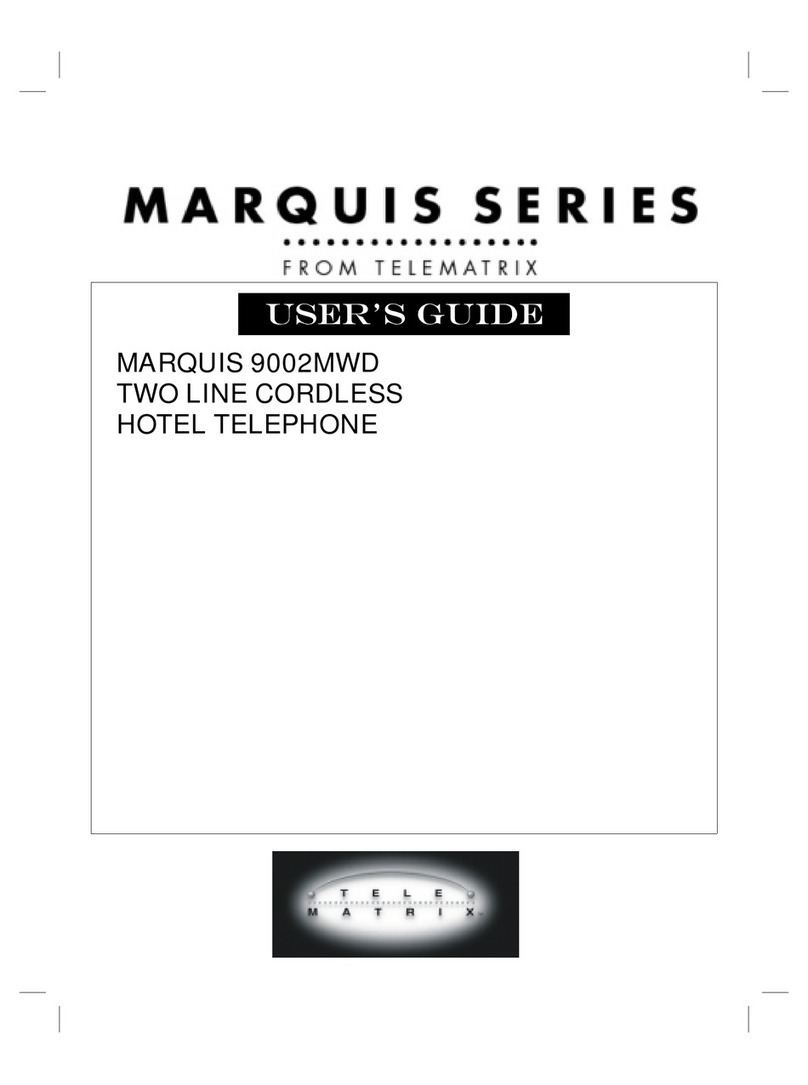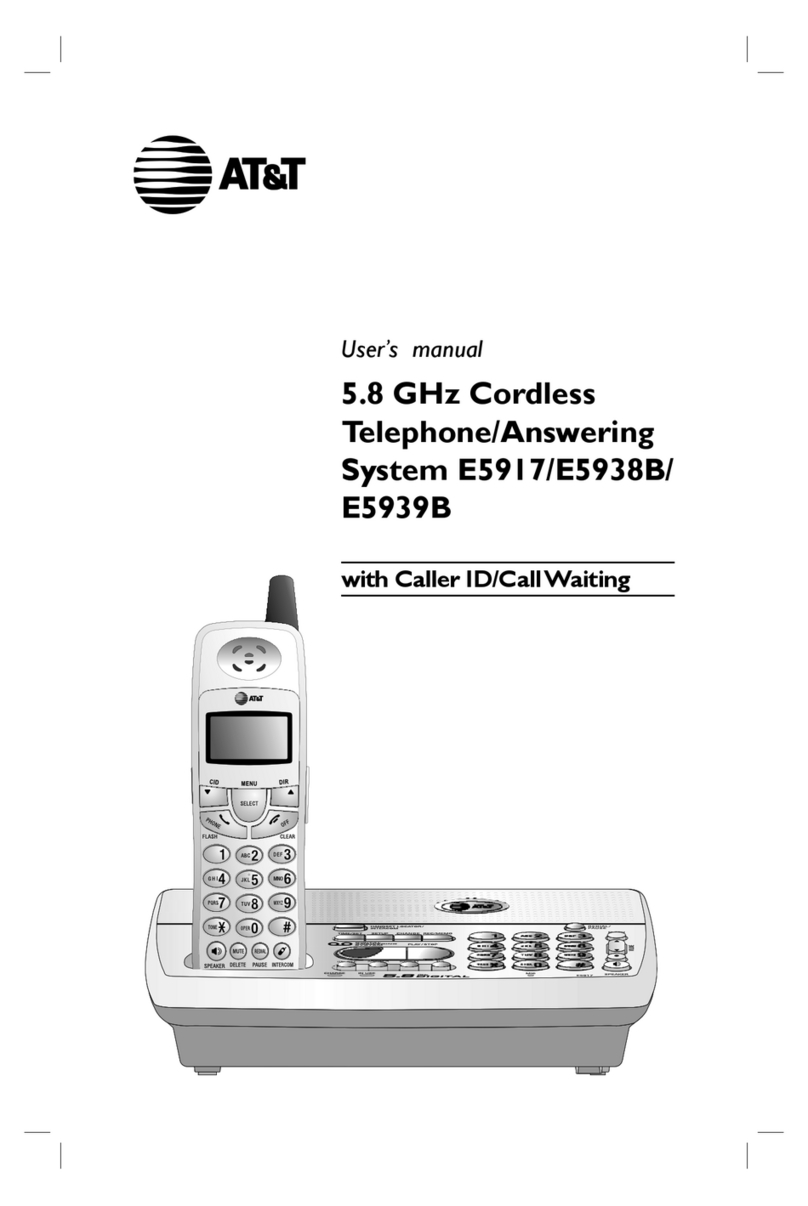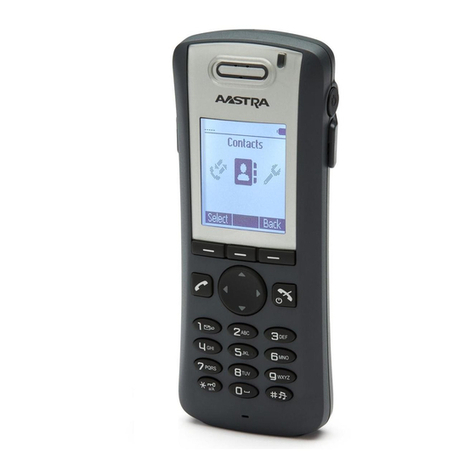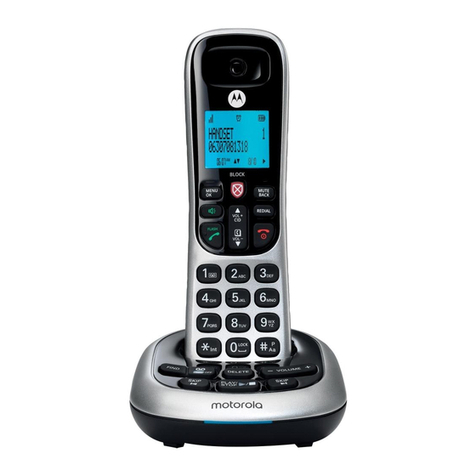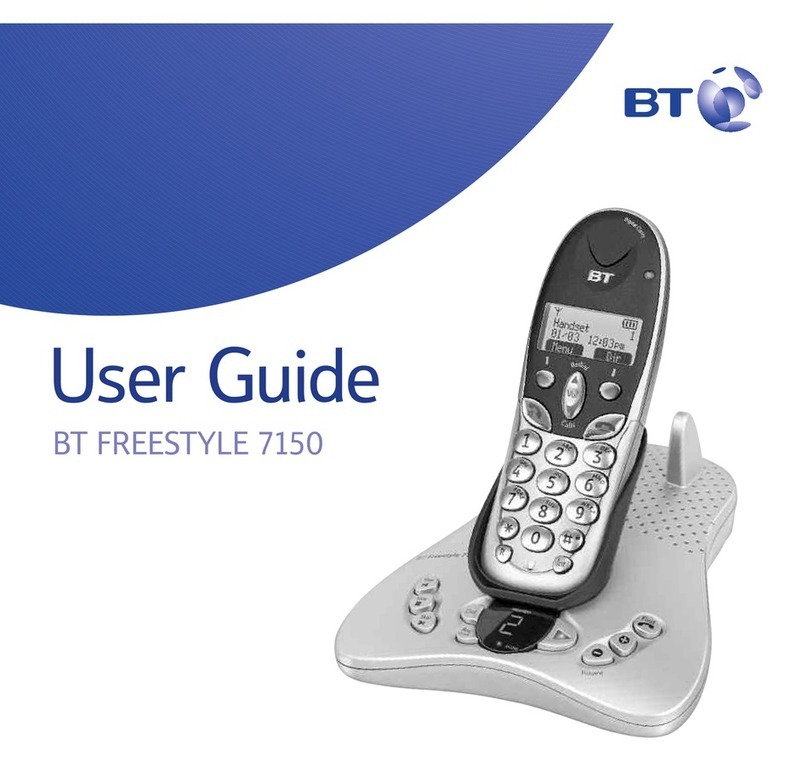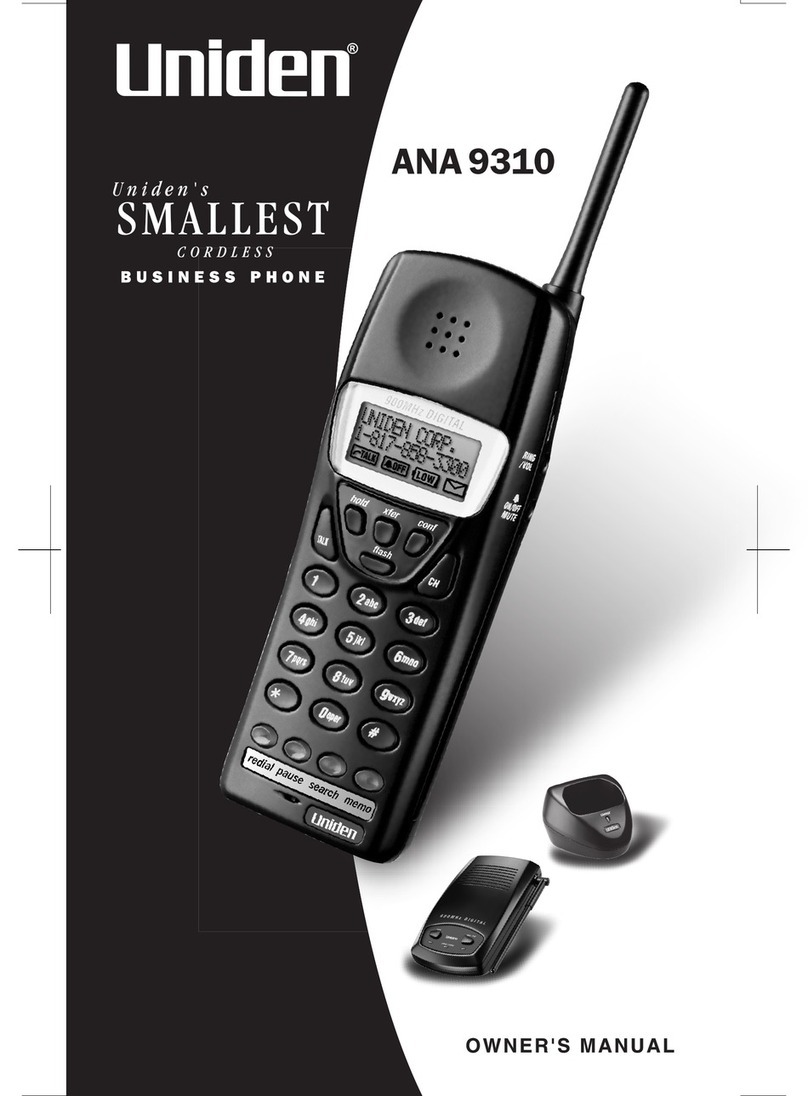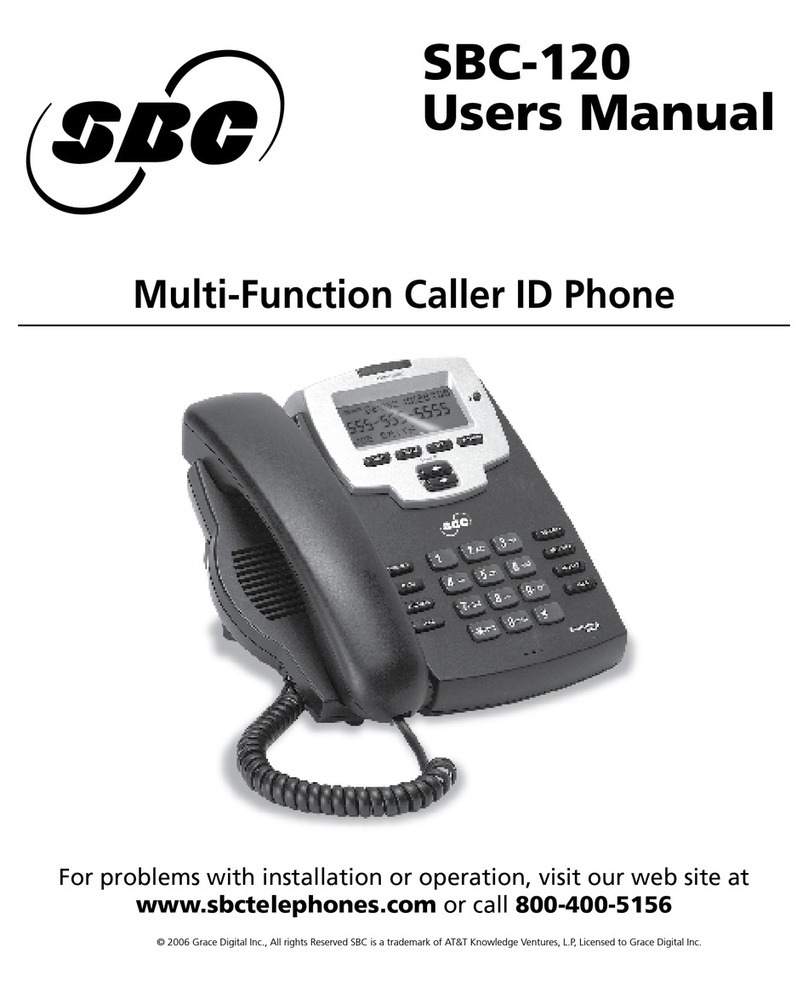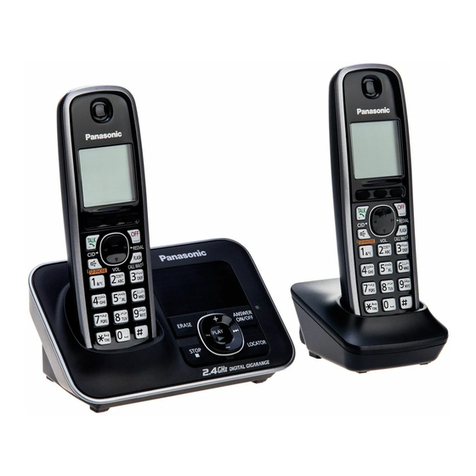Sagem D60C User manual

User Guide
C
06
Livre du D60_GB.book Page 1 Mercredi, 8. décembre 2004 10:01 10

INTRODUCTION
Dear customer:
Thank you for purchasing a SAGEM DECT telephone; we appreciate your trust in us.
Thisproduct was manufactured with the upmost care, should you encounter any difficulties during its use, we
recommend that you refer to this user guide. You can also find information on the following site:
http://www.sagem.com/faq
For your comfort and safety, we ask that you read the following paragraph carefully:
Recommendations and safety instructions
Your DECT telephone must not be installed in a humid room (wash room, bathroom, laundry room,
kitchen, etc.) unless it is 1.50 m away from a water point, or outside. Your telephone must be
operated at temperatures ranging from 5°C to 45°C.
Only use the supplied power adapter, connect it to the base socket according to the installation
instructions provided in this booklet and the indications on the identification label affixed to it
(voltage, current, electric network frequency). As a safety measure, you can use the power adaptors
to cut off the 230V current in case of danger. They must be located near to the device, and must be
easily accessible.
This telephone was designed for use on the public switched telephone network (PSTN). In case of
a problem you must first contact your reseller. Only use the supplied telephone cord.
For your personal safety, never place your handset on the base without the batteries, or without the
battery cover, you could get an electric shock.
To avoid damaging your handset, only use certified rechargeable AAA batteries NiMH 1.2 V
600 mAH, never use non rechargeable batteries. Insert the batteries in the handset battery
compartment respecting polarity.
At the end of their useful life, batteries must be disposed of according to the recycling instructions
presented in this booklet.
Your DECT telephone has an inside radio range of about 50 metres and up to 300 metres in open
space. The immediate presence of metal parts (of a television for example), or of any electric
appliance may result in range reduction.
Some sensitive medical equipment and safety equipment may be affected by the radio-frequency
transmissions of your telephone. In all cases, we ask that you respect the safety recommendations.
In areas where storms are frequent, we recommend that you protect your telephone line using a
surge protection device.
This equipment does not function in the case of an electric network shutdown: For the
emergency calls, use a self-contained cord telephone.
The CE marking certifies that the product meets the essential requirements of Directive 1999/5/CE
of the European Parliament and of the Council pertaining to microwave radio equipment and
telecommunication terminal equipment, for the safety and health of users, for electromagnetic
interference. Furthermore, it efficiently uses the frequency spectrum attributed to ground and spatial
communication to prevent damaging interference.
The declaration of compliance may be looked up on the www.sagem.com site, section "support" or
can be obtained from the following address:
SAGEM SA - Customer relations department
4 rue du petit albi - 95800 Cergy Saint-Christophe -France
Livre du D60_GB.book Page i Mercredi, 8. décembre 2004 10:01 10

I
Your telephone 1
Unpacking 1
Your base 1
Your handset 2
Connecting the base 3
Handset set-up 4
Handset turning on and off 4
Replacing the batteries 5
Getting started 6
Making a call 6
Receiving a call 6
During a call 6
Handsfree 6
Call transfer 7
During a call 7
Accessing the phonebook or call log 8
Secret mode 8
Ending a call 8
Communication between two handsets 8
Menu structure 9
Your phonebook 11
Viewing the phonebook 11
Creating an entry 11
Using a phonebook entry to place a call 12
Searching for a contact 12
Performing a quick search 12
Performing a refined search 13
Editing an entry 13
Deleting an entry 13
Sending a SMS from phonebook 13
SMS service 14
Sending a text message 14
Writing a text message 14
Sending an SMS 16
Reading a message 17
Managing read messages 17
Modify the SMS mode 18
Viewing the memory status 18
Emptying an SMS folder 18
Sending SMS text messages from
mobile phones 19
When replying to a telephone from
a mobile phone 19
When sending a new message to a
telephone from a mobile phone 19
SMS settings 20
Modifying the SMS centre numbers 20
Choose the SMS transmission centre 20
Modifying the terminal number 20
SMS boxes 21
Sub-Addressing 21
Creating a personal box 22
Viewing a message from a personal box 22
Modifying or removing a personal box 22
Call log 23
Viewing the received and dialled call log 23
Calling the last number dialled (Redial) 24
Calling a number listed in the dialled and
received call log 24
Viewing the events log 24
Accessories 25
Alarm clock 25
Setting the alarm clock 25
Activating or deactivating the
alarm clock 25
Modifying the alarm clock time 25
Changing the alarm clock ring tone 25
Timer 26
Changing the programmed time
of the timer 26
Changing the timer ring tone 26
Displaying or hiding the programmed
time of the timer 26
Birthday alarms 27
Adding a new birthday alarm 27
Viewing a birthday alarm 27
Modifying or deleting a birthday alarm 27
Monitoring a room 27
Customising the handset 29
Changing the ring tones 29
Activating or deactivating the beeps 29
Activating/deactivating the silent mode 29
Modify the idle screen 30
Modify the colour of the menu
backgrounds 30
Security 31
Locking/unlocking the keypad 31
Programming an emergency number 31
Defining the call time limit 32
Modifying the base code 32
Defining forbidden prefixes - Call barring 33
Authorising listening in 33
Settings 34
Programming a key 34
Modifying the date and time 34
Using the auto hang up and pick up
features 34
Modifying the Voice box number 35
Modifying the language 35
CONTENTS
Livre du D60_GB.book Page I Mercredi, 8. décembre 2004 10:01 10

II
Handset settings 36
Registering a new handset to a base 36
Modifying the base preference 36
Resetting the handset 37
Personal registering 37
Base settings 38
Using a handset to put the base
in registration mode 38
Resetting the base 38
De-registering a handset 39
Renaming the base 39
Line settings 39
Modifying the network type 39
Modifying the dialling mode 40
Modifying the flash duration
(R key) 40
Setting a PABX prefix 41
Appendix 42
Care and Maintenance 42
Problems 42
Features 43
Environment 44
Warranty 45
CONTENTS
Livre du D60_GB.book Page II Mercredi, 8. décembre 2004 10:01 10

1
YOUR TELEPHONE
Unpacking
Place the box in front of you, open it and make sure it contains the following items:
• one base,
• one handset,
• one battery compartment cover,
• one equipped power adapter,
• one telephone line cord,
• three rechargeable batteries,
• this user guide.
In the case of purchasing a pack duo or trio, you will find in addition for each
additional handset :
• a handset charger,
• an additional battery flap,
• three additional rechargeable batteries.
Your base
It fits well into your family environment.
Handset location Power indicator light
Fixed green indicator: Powered
Flashing green indicator:
- handset on line,
- handset paging,
- handset registration.
Base button
Pressed briefly:
- handset paging.
Held down:
- handset registration.
Livre du D60_GB.book Page 1 Mercredi, 8. décembre 2004 10:01 10

2
YOUR TELEPHONE
Your handset
With its user-friendly design, you will appreciate how easy it is to hold and its quality during
conversations.
The navigator key, a rapid selection tool.
Colour graphics
display
Program keys
Phonebook key
Pick up
Handsfree
Redial (long press) Alphanumeric
keypad
Key 1:
hold down for
quick access to
voice messaging
service
Hang up
Direct SMS access
Speaker
Microphone
Navigator
LED
Incoming message
warning beeps
R key
To cancel, delete or go to the
previous menu
Navigating To confirm or to access a sub-menu
Livre du D60_GB.book Page 2 Mercredi, 8. décembre 2004 10:01 10

3
YOUR TELEPHONE
The visual display of your handset
Connecting the base
On the bottom part of the base, click in the
telephone jack in its socket (as shown on the
drawing) and connect the other end of the
lead to the wall telephone socket.
Connect the end of the mains power unit lead
to the bottom of the base and the mains
power unit to the mains socket. The mains on
indicator located on the base comes on
green.
Route the wires in the guides and put the
base where it should be.
When the battery charge icon is at minimum, your screen will not be lit and the volume
level of the hands-free function will be decreased until the battery is recharged.
Before making any connections, please refer to the safety instructions presented at
the beginning of this user guide.
1
03/01 00:00
Mute
Redial
Battery indicator
Time
Date
Name of programmed functions in
and keys.
Number of handset
Telephone socket
Power socket
Livre du D60_GB.book Page 3 Mercredi, 8. décembre 2004 10:01 10

4
YOUR TELEPHONE
Handset set-up
Insert the batteries one after the other in
compliance with the battery polarity, as
shown on the label in the handset. Place the
cover back on the handset by pushing
upwards until it is completely closed.
Remove the protective film on the screen,
place the handset on the base to fully charge
the batteries.
The charging icon appears on the screen, it
indicates the charging status. Once the icon
is full, your batteries are charged.
Handset turning on and off
To turn off the handset, hold down the red key . The "OFF" message is displayed on the
screen. Your handset is now switched off.
To turn on your handset, hold down the green key . The name SAGEM is displayed on the
screen.
Information is displayed on the screen, including the battery charging indicator icon, the
handset number (for example 1), the date, the time and the function keys.
Only use certified rechargeable batteries. For optimal battery charge, leave the
handset on the base for at least 12 hours during initial use. During charging, the
batteries may heat up, this is quite normal and without risk.
Livre du D60_GB.book Page 4 Mercredi, 8. décembre 2004 10:01 10

5
YOUR TELEPHONE
Replacing the batteries
Hold down the red key to turn off the
handset. Turn it around so that the battery
compartment is accessible.
Put a sharp object (ball point pen, paper clip,
etc.) perpendicular to the handset, in the hole
marked 1 on the drawing opposite, and move
upwards towards the top of the handset. The
battery door opens. Slide it downwards (item
2).
Remove the old batteries, insert the new
batteries one by one in compliance with the
polarity of the batteries as shown on the label
fixed in the handset.
Place the cover back on the handset by
pushing upwards until it is completely closed.
At the end of their useful life, batteries must
be disposed of according to the recycling
instructions presented in this booklet.
To avoid damaging your handset, only use certified rechargeable AAA batteries NiMH
1.2 V 600 mAH, never use non rechargeable batteries.
1
2
Livre du D60_GB.book Page 5 Mercredi, 8. décembre 2004 10:01 10

6
GETTING STARTED
A language selection screen is displayed.
Press or until the required language is
displayed. Press Valid. .
Making a call
Enter the number of your contact using the
keypad keys.
If you enter an invalid digit, press Con the
navigator key to erase the incorrect
digit. Press the green key on your
handset to make the call.
Receiving a call
When you receive a call your telephone
rings. If you have subscribed to a "Caller
display" service, the caller's information
appears on the screen (unless your caller
has enabled the anonymous mode),
otherwise the "UNKNOWN" screen is
displayed.
Contact your service provider to find
out which services are available
(caller display service, SMS, etc.)
and the charges involved.
You can also make a call by:
- Pressing the green key to
access the line.
- Dialling your contact's number.
During communication, you can
increase or decrease the audio
volume of your handset by pressing
the
or
key on the navigator.
Pick up by pressing the green key or .
To turn off the ringer, press the silence
key .
At the end of the conversation, press the red
key .
During a call
During a call, numerous options are
accessible by pressing Menu .
Select the desired option in the following list:
- HANDSFREE: to activate the handset
speaker.
- CALL TRANSFER: to transfer the call to
another handset.
- SECOND CALL: to make a second call.
- PHONEBOOK: to access the phonebook.
- CALLS: to access the call log.
-SECRET: to mute the handset microphone.
Handsfree
While having a conversation with your
contact, you can enable the handset
loudspeaker. Press Menu .
Select HANDSFREE. Press Activ. .
When pressing the green key
while engaged in a conversation you
automatically activate the handsfree
mode of the handset, by pressing it
again you deactivate the handsfree
mode.
When the battery charge icon is at
minimum the hands-free function is
turned off until the battery is
recharged.
GETTING STARTED
Livre du D60_GB.book Page 6 Mercredi, 8. décembre 2004 10:01 10

7
The message HANDSFREE ACTIVATED
appears on the screen. Increase or decrease
the audio volume using or .
Call transfer
This function is only accessible when two
handsets or more are registered to the same
base. You can now transfer the call in
progress to another hand set.
During communication, press Menu .
Select CALL TRANSFER using or .
Press Valid. .
Select the handset you want to call using
or . Press Call .
The handset called rings, once someone
picks up transfer the call by pressing the red
key .
To retake the call before it is picked up by the
handset called, press Menu .
Select HANGING UP using or . Press
Valid. .
During a call
During a call, you can receive a second
incoming call or place a call to a second
contact. You can then switch from one
contact to the other, or have a conference
(depending on your service provider and
subscription).
Receiving a second call whilst on line
During the call, a beep is transmitted to your
telephone by your service provider to let you
know that you have a second call waiting.
Press + to take this new call.
Your other caller is then put on hold and you
can talk with your second caller.
Making a second call whilst on line.
During a call, you can put your contact on
hold and call a second one by pressing
Menu .
Select SECOND CALL using or . Press
Valid. .
Select your contact's telephone number in
the phonebook by pressing and press
Valid. or dial the number using the
keypad and press Call .
The second call is then launched, with the
first call still on hold.
To alternate from one call to the other
Press Menu .
Select SWITCH using or . Press
Valid. .
The call in progress is put on hold, and you
can then take the second call.
To end one of the calls and continue the
other one
Press Menu .
Select HANGING UP using or . Press
Valid. .
The call in progress is definitely terminated,
and you can then take the second call.
GETTING STARTED
Livre du D60_GB.book Page 7 Mercredi, 8. décembre 2004 10:01 10

8
To set up a 3 way-call (the two parties and
yourself)
Press Menu .
Select 3-PARTY CONF using or . Press
Valid. .
You can then talk to both parties
simultaneously.
To end the 3 way-call, press the red key .
Dual incoming call management can also be
done via the R key .
- Accepting a second incoming call: + .
- Making a second call during
communication: + recipient number.
- Alternating from one call to the
other: + .
- Ending a call and switching to the call on
hold: + .
- Setting up a 3 way-call: + .
Accessing the phonebook or call log
During a call, you can access your
phonebook to look up a telephone number, a
name contained in an entry or information on
calls stored in your call log.
During a call, press Menu .
Select PHONEBOOK or CALLS using or
and press Valid. .
Return to the communication menu using .
Secret mode
You can switch to secret mode at any time
during your conversation. Your handset
microphone will be switched off and the other
person will not be able to hear you.
To activate secret mode:
During a call, press Menu .
Select SECRET using or . Press
Activ. .
The SECRET MODE message will appear on
the screen.
To deactivate secret mode:
Press Exit .
Your correspondent will be able to hear you
again.
Ending a call
At the end of the conversation, press the red
key .
Communication between two
handsets
To communicate between handsets, both
handsets must be matched to a single base,
and must be within range of the base.
From the idle screen, enter the number of the
handset. Then press the green key .
The called handset rings. Pick up on the
second handset using the green key .
To end the call, press the red key .
You can also choose to deactivate
the secret mode by the Ckey on the
navigator panel.
Calls between handsets (internal
calls) are not affected by the call
time limit.
GETTING STARTED
Livre du D60_GB.book Page 8 Mercredi, 8. décembre 2004 10:01 10

9
You can navigate through the menus using the navigator key .
MENU STRUCTURE
SMS CENTERS
SUB-ADDRESS
PRIVATE BOX
VIEW
Option
PHONEBOOK
CALL
EDIT
SEARCH
RING TONE
SEND SMS
ADD NUMBER
NEW ENTRY
DELETE
EDIT SMS
SMS
READ SMS
MEMORY
EMPTY BOX
SETTINGS
INCOMING CALLS
CALLS
OUTGOING CALLS
ALARMACCESSORIES
TIMER
BIRTHDAY
ROOM MONITOR.
KEYPAD LOCK
SECURITY
EMERGENCY
TIME LIMIT
RESTRICTION
CHANGE CODE
INTRUSION
EXTERNAL CALL
INTERNAL CALL
BEEPS
SILENT MODE
RING TONEPERSONALIZ.
SCRN BCKGRND
AMBIANCE
EVENTS
Livre du D60_GB.book Page 9 Mercredi, 8. décembre 2004 10:01 10

10
MENU STRUCTURE
PROGRAM KEYSSETTINGS
DATE/TIME
AUTO HANG UP
AUTO PICKUP
LANGUAGE
VOICE BOX No
ADVANCED SET.
NETWORK TYPE
DIAL
FLASHING
PABX PREFIX
SET LINE
REGISTRATION
BASE PRIORITY
RESET HANDSET
PERSON.REGISTR
REGISTR.MODE
DELETE HANDSET
RESET BASE
SET BASE
RENAME BASE
SET SMS
SET HANDSET
Livre du D60_GB.book Page 10 Mercredi, 8. décembre 2004 10:01 10

11
YOUR PHONEBOOK
You can store 40 phonebook entries in your
phonebook.
Each phonebook entry can contain the name
of your contact which can be a maximum of
12 characters long (spaces included), your
contact's telephone number up to 24 digits
and an icon identifying the type of number
(work, home, mobile...).
You can associate a unique ring tone to each
entry and thus create your own call groups.
(To use this service, the caller id service must
be activate on your line.)
Viewing the phonebook
On the navigator key , press or
until the PHONEBOOK screen is displayed,
press OK to confirm (you can access the
phonebook directly using the key).
The list of phonebook entries organised in
alphabetical order appears.
Select the entry you want to view using or
. Once you have selected it, press OK to
confirm.
Once the entry appears on the screen, press
to display all of the available actions that
can be executed via the phonebook entry:
The first time you access your
phonebook, only the New element
appears in the list.
You can call the number that is
associated to the entry directly by
pressing the green key .
- CALL: to call the number associated to the
entry.
-EDIT: to edit the entry (name, number,
icon).
-SEARCH: to search for another entry.
- RING TONE: to assign a unique ring tone to
your handset that will be used each time
this number calls you (caller display service
mandatory).
-SEND SMS: to send an SMS to a number
associated to the entry.
- ADD NUMBER: to enter a new number for
the same name.
- NEW ENTRY: to create a new entry in the
phonebook.
- DELETE: to delete the entry from your
phonebook.
- VIEW: to view the entry data.
Select the action you wish to perform using
or . Press Valid. .
To exit the phonebook, press the red key .
Creating an entry
Alphanumeric keypad key correspondence.
1
A, B, C, a, b, c, 2
D, E, F, d, e, f, 3
G, H, I, g, h, i, 4
J, K, L, j, k, l, 5
M, N, O, m, n, o, 6
P, Q, R, S, p, q, r, s, 7
T, U, V, t, u, v, 8
W, X, Y, Z, w, x, y, z, 9
special characters
space, +, @, -, $, &, %, 0, /
# , " . : ; ! ? ’ ( ) _
To enter text press successively on the
desired key until the letter is displayed on the
screen.
YOUR PHONEBOOK
Livre du D60_GB.book Page 11 Mercredi, 8. décembre 2004 10:01 10

12
On the navigator key , press or
until the PHONEBOOK screen is displayed,
press OK to confirm.
Select New. Press Valid. .
The name input screen appears.
Using the keypad keys, enter the name of
your contact by pressing successively on the
corresponding keys. In case of a mistake,
press Cto erase one character at a time.
Once you are done making your changes,
press Valid. .
The number input screen appears.
Now, enter the name of your contact using
the keypad keys. In case of a mistake, press
Cto delete one character at a time.
Once you are done making your changes,
press Valid. .
Select an icon for this number, usingor
to specify the type of number:
Once the icon is selected, press Valid. .
A new entry is created. It appears in the
phonebook list. The name of this entry
corresponds to the beginning of your
contact's name which is preceded by a type
icon.
: HOME : MOBILE
: WORK : FAX
Using a phonebook entry to
place a call
On the navigator key , press or
until the PHONEBOOK screen is displayed,
press OK to confirm.
The list of alphabetical phonebook entries
appears.
Select your contact using or .
Press the green key to make the call.
Your handset displays the number of your
contact and dials this number automatically.
Searching for a contact
When referring to your phonebook, you can
search for a contact by:
• navigating through the list using
,
,
• using quick search,
• using refined search.
Performing a quick search
Access your phonebook list, press
successively on the keypad key which
corresponds to the first letter of the name you
are searching for so as to make it appear at
the top of the screen.
Once the first letter of the name is displayed,
wait a moment.
The phonebook selects the first name in the
list that starts with the selected letter.
Press or to select the specific entry that
you wish to view or call, press OK to confirm.
YOUR PHONEBOOK
Livre du D60_GB.book Page 12 Mercredi, 8. décembre 2004 10:01 10

13
Performing a refined search
In the phonebook menu, press Option .
Select SEARCH using or . Press
Valid. .
Using the keypad, enter the first three letters
of the contact you are searching for.
The phonebook positions itself to the entry
which comes closest to those two characters.
Press or to select the specific entry that
you wish to view or call, press OK to confirm.
Editing an entry
To edit a phonebook entry (change the
name, the number and/or the number type
icon), enter the phonebook, select the entry
you want to edit and confirm using OK to
display it on the screen.
Once the entry is displayed on the screen,
press Option .
Select EDIT using or . Press Valid. .
You enter the name input screen. The cursor
is at the end of the name.
• The information is accurate. Press
Valid. .
• To correct the name, press Con the
navigator key to delete characters.
Make your corrections using the keypad
keys by pressing successively on the
corresponding keys. Once you are
finished, press Valid. .
You enter the number input screen. The
cursor is at the end of the number.
• The information is accurate. Press
Valid. .
• To correct the number, press Con the
navigator key to delete the
numbers. Enter the new number and
press Valid. .
Select the icon according to the type of
number entered using or . Press
Valid. .
To exit the menu, press the red key .
Deleting an entry
To delete an entry, enter the phonebook,
select the entry, press Option .
Select DELETE using or . Press
Valid. .
A confirmation screen asks you if you wish to
delete the entry.
• If you do not wish to delete the entry,
press No .
• To delete the entry, press Yes . The
entry is deleted from the phonebook.
To exit the menu, press the red key .
Sending a SMS from phonebook
On the navigator key , press or
until the PHONEBOOK screen is displayed,
press OK to confirm.
Select the contact using , keys or
keypad, enter the first three letters of the
contact. Press or to select the specific
entry then press Option .
YOUR PHONEBOOK
Livre du D60_GB.book Page 13 Mercredi, 8. décembre 2004 10:01 10

14
Select SEND SMS using or . Press
Valid. .
A text input screen appears. refer to
paragraph Sending a text message, page
14.
SMS SERVICE
You can use your DECT telephone to send,
receive and track SMS messages. You can
send SMS messages either another fixed
SMS-capable telephone or a mobile
telephone.
Sending a text message
On the navigator key , press or
until the SMS screen is displayed, press OK
to confirm ( can also be used to directly
access the SMS menu).
Writing a text message
Once in the SMS menu, press or until
the EDIT SMS appears. Press Valid. .
Use the , keys to select either Common
box or a personal box if one has been
created. Press Valid. .
The SMS will be sent to the box selected.
The SMS sending and receiving
functions of your telephone are only
functional if your service provider
offers the corresponding service to
its subscribers.
To send and receive SMS text
messages, you need the telephone
numbers of your Network’s SMS
Centre.
YOUR PHONEBOOK
Livre du D60_GB.book Page 14 Mercredi, 8. décembre 2004 10:01 10

15
Enter the code of the box, if you have
selected a personal box. Press Valid. .
A text input screen appears.
Using the keypad keys, enter the text
message by pressing successively on the
corresponding keys.The capital letters are
accessible by long press on .
Alphanumeric keypad key correspondence
depending on the activated mode (capital
letters or small letters).
’, 1, #, ,, ., :, ?, _,*
a, b, c, 2
d, e, f, 3
g, h, i, 4
j, k, l, 5
m, n, o, 6
p, q, r, s, 7
t, u, v, 8
w, x, y, z, 9
special characters
espace, 0, /, +, @, -, $, &, %
#
To enter text press successively on the
desired key until the letter is displayed on the
screen.
If no personal box has been created,
only the shared box is displayed on
the screen.
To create a personal box, select
PersoBox Menu and press
Valid. . Follow the instructions
displayed on the screen. For further
details, refer to the paragraph
Creating a personal box, page 22.
Making a correction
If you enter the wrong letter, press Con the
navigator key to delete one character at
a time.
You can also move through the text to delete
characters or insert new ones.
Use or to move through the text. Once
you have reached the location where you
want to insert or delete a character. Press
Select .
Select INSERT CHAR. or DELETE CHAR.
using or , depending on the operation
you want to carry out. Press Valid. .
Capital letters/Small letters
When writing your message, you can enter
capital letters or small letters.
During the SMS input, press Select .
Select CAPITAL LETTER or SMALL
LETTER. Press Valid. .
Special characters
During the writing process, certain special
characters are accessible by doing the
following.
Press the button, using or and the
keypad numbers, select the desired
character, use to confirm.
SMS SERVICE
Livre du D60_GB.book Page 15 Mercredi, 8. décembre 2004 10:01 10

16
SMS SERVICE
List of special characters:
Sending an SMS
Once you are done writing your text
message, press Select to select the type
of delivery.
You can choose between the following
options:
- SEND: to send a message.
- STORE: to save your text as a draft. It can
be sent at a later time. The draft message is
archived in the "Draft" box.
- CANCEL: to permanently delete the text
message that you just entered.
To transmit message
Select SEND using or . Press Valid. .
Enter or search for the receiver's number.
• Enter the number using the keypad.
Press Valid. .
or
• If the receiver is listed in the phonebook
as one of your contacts, press (refer
to paragraph Searching for a contact,
page 12). Press Valid. . Your
contact's number appears. Press
Valid. .
A confirmation screen appears. It indicates
the type of transmission and the number to
which your message will be sent.
• If the information is accurate. Press
Confirm . A message appears on the
screen indicating that the transmission of
your SMS is in progress.
• To change the phone number, edit or
modify your text message, press Modify .
Press Edit .
At the end of the transmission, you can save
a copy of your message. It will be stored in
the Sent SMS folder.
• To save the message, press Yes .
• If you do not want to save the message,
press No .
In the event of a delivery failure
An information screen appears indicating
that your service provider was unable to
deliver your message.
Press CONT. .
Different options come up on the screen:
- SAVE: to save your text in draft form. Once
it is saved, you will be able to resolve the
potential problems and send your message
at a later time without having to enter it
again.
-TRY AGAIN: to attempt a new delivery.
- DELETE SMS: to permanently delete your
SMS.
- SEE RECEIVER: to check the phone
number or send the SMS again.
- EDIT: to change the delivery type and
number or your text.
Choose an action using or . Press
Valid. .
Livre du D60_GB.book Page 16 Mercredi, 8. décembre 2004 10:01 10
Table of contents
Other Sagem Cordless Telephone manuals
